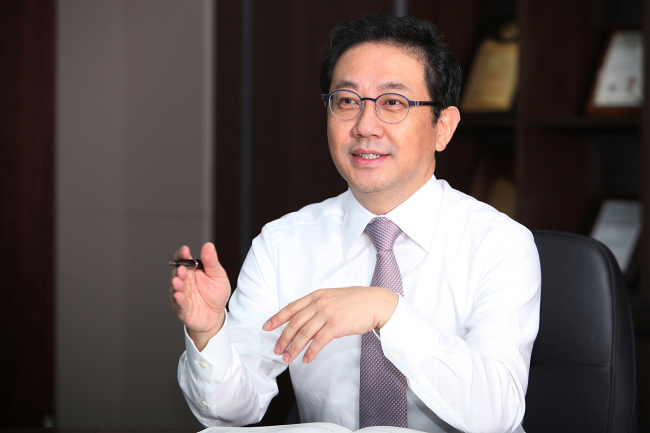There is an ongoing race among global smartphone makers to introduce smartphones with the display fingerprint authentication solution, and CrucialTec is at the center of the competition, as it owns the largest number of patents related to the solution and its technologies.
“CrucialTec is the only company in the world which possesses all five technologies required for high-quality on-display fingerprint authentication -- sensor integrated circuit (IC), chip packaging, module, algorithm, mobile firmware,” Ahn said. “The key to being able to commercialize such smartphones is to well match display panels with our sensor and drive ICs.”
Samsung Electronics had attempted to adopt a display fingerprint solution in its flagship Galaxy S8 smartphone early this year, but halted the development due to technological hurdles.
Apple has also reportedly given up on the development of a touch sensor IC for the upcoming iPhone 8, which would have enabled both screen touching and fingerprinting on a single display, according to foreign news reports this week.
Samsung is reportedly working with Synaptics, a San Hose-based biometrics firm on the new solution, while Apple owns Authentic, which develops such displays.
Considering that Samsung and Apple are both struggling to release such smartphones at the moment, the ball is in CrucialTec’s court.
CrucialTec was the world’s first to supply its fingerprint solution Biometric TrackPad, known as BTP, to Huawei, Meizu, OPPO, Vivo, Google, MS, Sony, Fujitsu and LG Electronics. It provided the solution to Fujitsu’s Disney smartphone series and Pantech’s Vega LTE-A in 2013, slightly earlier than Apple’s iPhone 5S series.
The company’s DFS is based on transparent touch screen pads with a hybrid IC that processes fingerprint authentication and touch screen sensing simultaneously. Other companies are currently developing similar solutions based on opaque IC chips, either with an optical or ultrasonic method, which have lower yields than the DFS, according to Ahn.
Since the hybrid IC is placed just under the tempered glass of the smartphone, and right on the display panel, the accuracy of fingerprint authentication and touch screen sensing improves, the CEO explained.
By using transparent electrodes, the DFS has reached 90 percent in clearness of viewing the display, which is the same level proven in existing smartphones without the additional display fingerprint solution.
CrucialTec’s competitors have developed solutions to place the fingerprint sensor IC under the main display panel, which is comparative to the DFS that shows higher accuracy, according to a company official.
“Our efforts go back five years when we first saw the need to develop the solution as the size of display panels for mobile phones got bigger and bigger,” Ahn said. “And we reached 50 percent in clearness three years ago, and further improved it to 90 percent, a very significant improvement.”
“The only remaining challenge is to overcome the glass in order to raise the accuracy of touching and personal authentication by continuing to improve the sensor capabilities,” he added.
According to Strategy Analytics, there will be a total of 1.6 billion units of low, mid-end and premium smartphones with fingerprint authentication solutions by 2020, up from 850 million units this year.
“We are already feeling the needs of the market,” Ahn said. “That is why we are continuing to invest in the DFS to improve further, including developments of follow-up technologies, despite some deficits.”
The company allocates at least 10 percent of its annual revenue for research and development, Ahn said.
Last year, the company posted 320 billion won ($282 million) in sales and 8.3 billion won in operating profit. But in the first quarter of 2017, it saw a 7.8 billion won operating loss due to R&D costs, despite 43.3 billion won in quarterly sales.
“We have already started investing in technologies for the next five years,” he said. “The area of the new techs will be mobile health care, which will be mainly based on Internet of Things technologies. We will never stop investing.”
Ahn is currently chairing the Korea Venture Business Association and is part of the presidential committee on job creation. He was formerly a senior researcher on optics at Samsung Electronics.
By Song Su-hyun (
song@heraldcorp.com)





![[Exclusive] Hyundai Mobis eyes closer ties with BYD](http://res.heraldm.com/phpwas/restmb_idxmake.php?idx=644&simg=/content/image/2024/11/25/20241125050044_0.jpg)
![[Herald Review] 'Gangnam B-Side' combines social realism with masterful suspense, performance](http://res.heraldm.com/phpwas/restmb_idxmake.php?idx=644&simg=/content/image/2024/11/25/20241125050072_0.jpg)

